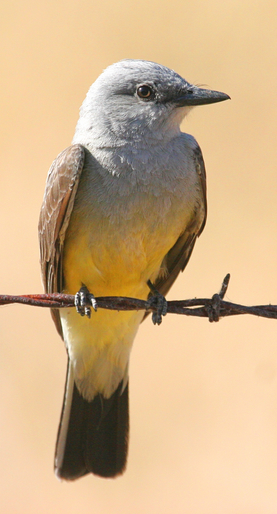The Western Kingbird is a conspicuous and aggressive bird of the open country. It is common throughout the western United States and southern Canada. However the breeding range of this kingbird has expanded over the past  century expanding into the Central Great Plains States, possibly due to the encroachment of trees into this vast prairie region. The introduction of trees in the Great Plains may have bridged an ecological barrier that helped the Western Kingbird to further expand its range. They have become occasional visitors along the East Coast during the fall months, and have been seen during the early winter months in Florida.
century expanding into the Central Great Plains States, possibly due to the encroachment of trees into this vast prairie region. The introduction of trees in the Great Plains may have bridged an ecological barrier that helped the Western Kingbird to further expand its range. They have become occasional visitors along the East Coast during the fall months, and have been seen during the early winter months in Florida.
The male and female Western Kingbirds are a medium sized songbird about 9 inches long. Their head, throat and upper breast are a light gray, while the belly is a bright yellow. The wings are dark and the tail is square tipped with white outer edges. This kingbird prefers open spaces with scattered trees, shrubs, or tall man-made structures from fence posts to telephone poles. Common habitats of the Western Kingbird include grasslands, desert shrub, pasture, open savannas, and urban areas.
Western Kingbirds are monogamous, returning each year to defend their rather loosely defined territory against other kingbirds. The nest is constructed primarily in trees, but they will also use utility poles, fence posts, and other man-made structures. A cupped nest is built of grass stems, roots, small twigs and bark comprise the outer structure, which is then lined with hair and feathers. Wool, cotton, and cloth have also been found in their nests. Up to 7 creamy white eggs are laid with heavy dark spots at the larger end. The female will incubate the eggs for 18 to 19 days. As the nesting season progresses, the territory of the Western Kingbird grows smaller until, by the time incubation of the eggs begin, is limited to the tree or structure the nest is located in. The young birds will fledge on another 16 to 17 days and will continue to rely on their parents for food.
Western Kingbirds, as with other flycatchers, will launch themselves off tall structures, fence posts, and tree limbs to feed on the wing catching most of their prey in the air. They will grab insects off the ground or from vegetation as well.
This Neo-tropical migrant winters in Central America, with a small population finding refuge on the southern tip of Florida.
Wingtip: A group of kingbirds are collectively known as a “coronation”, “court”, and “tyranny” of kingbirds.
 century expanding into the Central Great Plains States, possibly due to the encroachment of trees into this vast prairie region. The introduction of trees in the Great Plains may have bridged an ecological barrier that helped the Western Kingbird to further expand its range. They have become occasional visitors along the East Coast during the fall months, and have been seen during the early winter months in Florida.
century expanding into the Central Great Plains States, possibly due to the encroachment of trees into this vast prairie region. The introduction of trees in the Great Plains may have bridged an ecological barrier that helped the Western Kingbird to further expand its range. They have become occasional visitors along the East Coast during the fall months, and have been seen during the early winter months in Florida.